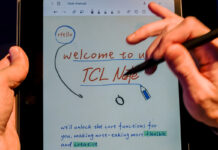
We as humans have tendencies to lose small things, with a common culprit being pocket items such as car keys and wallets. Tile and TrackR aim to solve that problem with their respective Bluetooth proximity trackers which utilize our smartphones to find small items within wireless range.
Tile & TrackR Form Factor
Both trackers intend for you to attach them to a keychain or bag. Therefore, they have been engineered to come in relatively compact form factors. Beginning with the Tile, the Mate comes in at just 4.65mm in thickness, weighs in at 6.1g, and measures in at 34x34mm. Though the Tile is incredibly small, the TrackR pixel comes in even smaller at a 26mm circular diameter, 5mm thick, and 4g in total weight. Regardless, both models are portable and fit in with a set of keys perfectly. One hardware feature the Tile has that the TrackR does not have, however, is an IP5 liquid resistance rating that may contribute to the longevity of the tracker through everyday situations.
 The Tile is also offered in a Slim model intended for wallets and phones which take up a larger surface area but comes in at a slimmer form factor than the Tile Mate. All features and specifications, however, are identical.
The Tile is also offered in a Slim model intended for wallets and phones which take up a larger surface area but comes in at a slimmer form factor than the Tile Mate. All features and specifications, however, are identical.
Wireless Range
The Tile’s and TrackR Pixel use Bluetooth 4.0LE (Low Energy) connectivity which has an advertised range of up to 100-120ft with exception to physical wireless transmission variables such as walls and furniture. From my experience under the same conditions, both trackers were detectable from a range up to around 100ft with the Tile having a slight edge beyond that mark. By navigating to the connected mobile app, each tracker is displayed on a map based on its last seen location, and an alarm can be triggered from your smartphone within seconds to find the lost item. Both trackers also use community settings to find other trackers within proximity in the event your tracker is outside of the given Bluetooth range.
Built-in Tracker Alarm
 When it comes to the built-in sound alarm of these trackers, the Tile comes in at 80DB while the TrackR registers at 90DB. Although these are rather respectable levels, an issue that is present on both and in particular on the TrackR is just how easy it is to cover out the speaker on the unit. This will be troublesome in situations where your keys and tracker are crammed in a crevice or in between the pillows on your couch where the sound could potentially be muffled. In open situations, however, the decibel rating is more than enough to quickly find your item within the given Bluetooth range.
When it comes to the built-in sound alarm of these trackers, the Tile comes in at 80DB while the TrackR registers at 90DB. Although these are rather respectable levels, an issue that is present on both and in particular on the TrackR is just how easy it is to cover out the speaker on the unit. This will be troublesome in situations where your keys and tracker are crammed in a crevice or in between the pillows on your couch where the sound could potentially be muffled. In open situations, however, the decibel rating is more than enough to quickly find your item within the given Bluetooth range.
Battery Life
 The advertised battery life of both the TrackR Pixel and Tile Mate/Slim is around one year, more or less depending on the frequency of use. One huge advantage that the TrackR Pixel has in this category, however, is the ability self-replace using a single CR2016. The Tile on the other hand only lasts as long as its battery, meaning you will have to replace the entire unit after the designated battery life is over. Tile does offer a ReTile program which offers a replacement discount, but a
The advertised battery life of both the TrackR Pixel and Tile Mate/Slim is around one year, more or less depending on the frequency of use. One huge advantage that the TrackR Pixel has in this category, however, is the ability self-replace using a single CR2016. The Tile on the other hand only lasts as long as its battery, meaning you will have to replace the entire unit after the designated battery life is over. Tile does offer a ReTile program which offers a replacement discount, but a
Mobile App

 Both trackers have a designated application available on iOS and Android. From my personal experiences, I didn’t experience issues on either; everything is well sorted out, intuitive and easy to connect with a tracker. The setup process is straightforward and informative, and I was able to have each respective tracker setup in less than a minute through Bluetooth. With that being said, I do prefer the interface of the Tile app as it has a cleaner minimalist feel and the homepage defaults to presenting all connected trackers for easy accessibility. The TrackR app has menus separated on the left and right side while defaulting to a map for the homepage. It all comes down to personal preference as to which interface you prefer more, but both were easy to use and access from myexperiences on iOS.
Both trackers have a designated application available on iOS and Android. From my personal experiences, I didn’t experience issues on either; everything is well sorted out, intuitive and easy to connect with a tracker. The setup process is straightforward and informative, and I was able to have each respective tracker setup in less than a minute through Bluetooth. With that being said, I do prefer the interface of the Tile app as it has a cleaner minimalist feel and the homepage defaults to presenting all connected trackers for easy accessibility. The TrackR app has menus separated on the left and right side while defaulting to a map for the homepage. It all comes down to personal preference as to which interface you prefer more, but both were easy to use and access from myexperiences on iOS.
Price & Value
When it comes to price and value, the initial cost is relatively close, but in the long term, the TrackR is a better value for one reason alone. The fact that you can self-swap the battery extends the overall longevity of the TrackR as opposed to the Tile becoming obsolete and useless as soon as the battery dies out within a one-year estimate. Despite the ReTile program, at the end of the day, a small and cheap battery will still be substantially cheaper than purchasing another tracking device.
Tile vs TrackR
From my experiences with the Tile Slim/Mate and TrackR, I found that both were able to do their job consistently. In many ways, they are very similar including the Bluetooth 4.0LE and 100ft or so tracking range, alarm decibel level, and compact form factor for keychains especially. But some additional features are found on the TrackR, including the replaceable battery and built-in LED for an extra level of object finding mechanism. I did conclude that the speaker on the TrackR was substantially easier to muffle when compared to the Tile however despite it being 10DB louder on paper. Objectively the app experience was very similar between the two, but I preferred the visual design of the well-established Tile platform especially after being a Tile customer for a couple of years now. When comparing the hardware, I also prefer the overall look of the Tile as opposed to the TrackR, which reminds me of the beepers found at fast food restaurant pickups, not a huge deal, but something worth noting when strapped to the keychain.
At the end of the day, the two trackers were good at what they set out to do and the deciding factor, in my opinion, is the form factor and ecosystem you would like to embed yourself within.



These devices would be great at keeping track of seniors who frequently get lost (ie dementia and/or Alzheimer’s). Just attach the tracker to their keychain.
Also great for young keeps to stay out too late.
As these device rely on users owning the apps. What happens if you have a friend or family member drive around town with the trackers on their bike or car? Which one is able to track more reliably with the user base?
Since these only use bluetooth, they have to be within range of someone with the app. The more users, the better the chance you’ll find your tracker. No matter which one has the overall larger community worldwide, it all comes down to the community thats around your tracker.
Good luck,my friend! my trackerR battery didn’t even last a month,and I didn’t get to use my tracker at all, nada!
I have decided not to purchase any more of this kind of junk.
I purchased the trackR a few months ago. I worked only for about a couple of weeks, then went kaput! I was not able to pair it to anything anymore. Needless to say, its in the garbage now! 🙁 I am very disappointed with this “tracker”:(
Don’t waste your hard earned money on this C.
Good video Justin. It will be interesting to see if battery actually last close to a year in this new model. TrackR’s previous model (TrackR Bravo) only lasted 3-4 months even with almost no use. They claimed it would last a year but it never even got close to it. The Pixel is much louder though and seems to be more water resistance without the need of a Water Resistant Case. Definitely a step in the right direction and only time will tell about the battery.
Comments are closed.